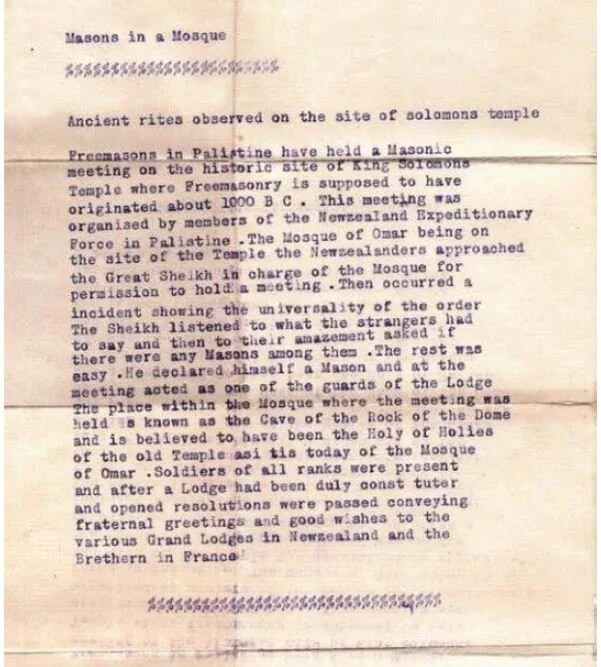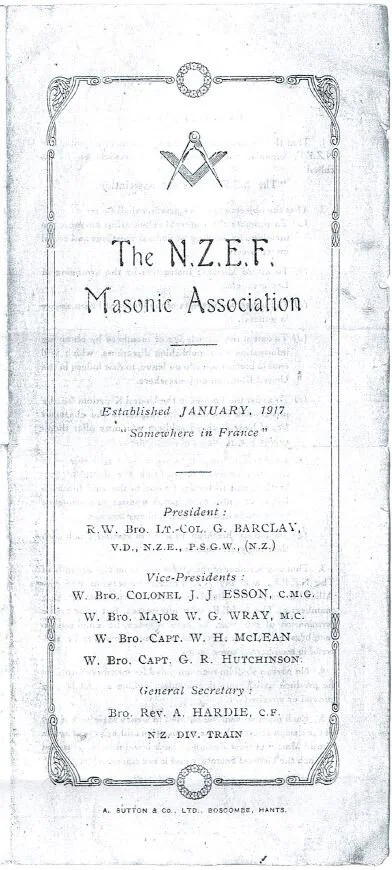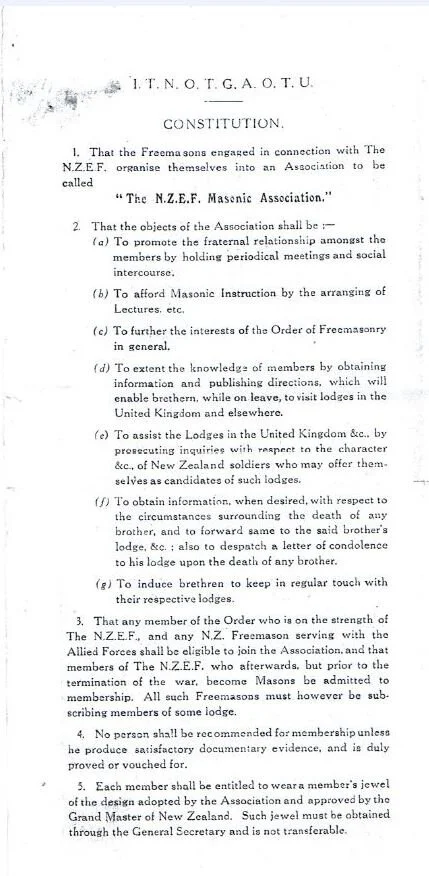The New Zealand Expeditionary Force Masonic Association
Thank you to wo. Grant Watson and the research lodge of otago No. 161 for their contributions to this page
In the Beginning; On the 27th May, 1917 on a hill near Gaza, 36 Freemasons from the New Zealand armed forces stationed in Palestine held a meeting (of necessity the Tyler was armed with a rifle not a sword). A portion of a paper by V W Bro G. H. Robertson, from the transactions of the United Masters Lodge 167, in May 1957, covers the story very well. It is taken from the 1918 Annual Report of the Association.
“There are many in the New Zealand E.F. who carried with them, from the day they left the doors of their Mother Lodges, the determination that if opportunity offered, they would band themselves together and enjoy during their active service the brotherly felicitations which were theirs in New Zealand. It was however only after the partition of the troops that the desire found expression. An association was formed in France, and another in Palestine. The preliminary meeting of the latter was at Tel el Fara on May 6th, 1917, when those present constituted themselves into a provisional committee for the purpose of formulating proposals to place before a meeting of Brethren to be called as soon as an opportunity offered. In accordance with the resolution, a meeting of Freemasons in the N.Z.M.R. was summoned for the 27th May 1917. The meeting took place in the open air on a hill slope overlooking Tel el Fara and some 2000 yards south of the Waddy Ghuzzeh. There were 36 Brethren representing 34 Craft Lodges present. The Association came into being named itself “NZEF (in Palestine & Egypt) Masonic Association’ adopted a constitution, appointed Officers, and sent greetings to Brethren in France and New Zealand. The great mobility of a mounted Force makes it extremely difficult to hold meetings, so it was not until April 4th 1918, at Jericho, that the Executive could make arrangements for another meeting. On the morning of April 6th a party left Jericho in 8 cars for Jerusalem. At 2.15 pm the Brethren met in the Mosque of Omar, and there in the natural cavern under that sacred rock of profound association, the meeting took place. The Lodge was opened in the first degree. There were present representatives of 27 Craft Lodges. The WM referred to the uniqueness of the occasion, and to the new page added to the history of Freemasonry that day. Not for centuries had a meeting been held on the Temple site and the members of the Association were honoured indeed to meet in peace and harmony on that spot adorned and hallowed by the three Ancient Grand Masters. Greetings were sent to the Grand Lodges in New Zealand and France.”
Further is an extract from the first AGM of the Association, which was held in Bethlehem on August 8th 1918.
“They rejoiced that the Association has become so firmly established and give thanks to GAOTU for the privilege of meeting as Brethren in the land so hallowed by the associations of our craft. The year has been a successful one. During it seventy three joined, and although a few have returned to New Zealand and some have made the Supreme Sacrifice, we commence the year with a membership of seventy. A striking incident of the year was a meeting held on the site of King Solomon’s Temple on April 6th 1918. It was a matter of regret that more meetings were not held. The mobility of the Force and the extensive operations during the year effectually precluded that ….”
The following is an extract from a letter from W Bro G Lovelock, PM, Lodge Otangaki No. 70, which appeared in the August 1918 issue of the “NZ Craftsman”.
“It was W Bro General Meldrum’s great hope that New Zealand Masons should hold a meeting as near as possible to the site of KST, and I am glad to tell you that that great event took place on Saturday, 6th April, at 3.15 pm, and with greater success than any of us dared to hope for, considering the difficulties that had to be overcome. But as Bro General Meldrum afterwards remarked, we gained all our objectives. We had been on a very trying ‘stunt’ to Mecca Railway, about 20 miles east of the Jordan, in very cold, wet, miserable weather, and had returned to the tropical climate of Jericho in the Jordan Valley, when it was suggested that, as we were twenty miles off Jerusalem, we should make an attempt to go there and hold a meeting. At first it seemed as though we were doomed to failure, as it was not until the Friday evening that permission was granted for us to go. On Saturday morning we mustered some thirty members and made a very pleasant trip to the holy city, in motor cars very kindly placed at our disposal by General Chaytor. We arrived there at mid-day, and after lunch at the new Grand Hotel (the best meal many of us had had for months) we made our way through the narrow streets of the old City to the Mosque of Omar, which covers the rock on which Abraham is said to have offered Isaac as a sacrifice, and on which King Solomon stood. Beneath the rock is a cave, and this we decided was the best place for our purpose, and with the help of the Sheikh of the Mosque (who proved himself on the S.) and much baksheesh, (money, backhander) we obtained the privacy of the cave for fifteen minutes, in which time we assembled and opened the Lodge, passed a few appropriate resolutions, and closed the Lodge again. We then went outside and were photographed.” Lovelock was the Junior Warden at the meeting.
Dome of the Rock meeting in April, 1918. Photo courtesy of Paley Downs.
Thomas Jackson’s account of the meeting at the Dome of the Rock:
Letter from Thomas Jackson describing the meeting at the Dome of the Rock. Photo courtesy of Nottingham Masons Magazine, Jan. 2019, pg. 18.
The Photo referred to was issued in a Supplement to the Transactions of the Masters and Past Masters Lodge 130 in September 1923 and shows 31 soldiers and an Arab Sheik, taken presumably outside the Mosque of Oman. This is more correctly known as the Dome of the Rock. Who the actual Sheik was is still a mystery, likewise how he proved himself a Freemason. The Sheik was one of two Tyler’s. Presumably due to the unusual circumstances and the general situation only fifteen minutes was allowed for the meeting.
The Officers at that Meeting are recorded as: Worshipful Master - W. Bro. W. Meldrum PM, Lodge Rangatira 71, Hunterville Senior Warden - Bro. J. N. McCarroll, Lodge Star of the North 1647 EC, Whangarei Junior Warden - W. Bro. G. R. Lovelock PM, Lodge Otangaki 70, Ashhurst Senior Deacon - Bro. B. Anderson, Lodge Havelock 104, Havelock Junior Deacon - Bro. J. Thomson, Lodge Karioi 165, Raglan Inner Guard - Bro. G. R. Mansford, Lodge Wairau 42, Blenheim Outer Guard - Bro. C. Tate, Lodge Sir Donald McLean 1646 EC, Waitara Chaplain - Bro. J. D. Wilson, Lodge Oamaru Kilwinning 82, Oamaru. (plus the Sheik )
It would seem that W. Bro. Meldrum had either been working very hard behind the scenes to ensure the success of the operation, or took a real punt that this whole expedition would succeed. Remember the whole site was forbidden to troops, and it was a holy Muslim site. Add the story of the Gavels (see below) and with transport at a premium, how did he manage seven vehicles for the trip from Jericho?
One interesting aside is the gavels used at the meeting. This has, quite rightly, caused W. Bro. Stockley to query aspects of this part of the records..
I quote from his paper: “The Gavels to be used at the meeting have proven to be something of an enigma. The Minutes of the Meetings, supported by subsequent reports written many years later, show that ‘a set of three Gavels was ordered’. In keeping with the symbolism which Freemasonry is steeped, the gavels ordered were to be made from three different woods, each having a symbolic significance, namely Acacia, Olive and Cedar wood from the forests of Lebanon. The research undertaken has revealed that various members of the group sent these gavels back to their Mother Lodges as important symbols of the only meeting ever held in King Solomon’s Temple by Freemasons. The gavels presented in this way were sent to New Zealand lodges and to a Lodge in Scotland (Lodge Cadder Argyle No. 147 ) and I was able to secure photographs of them as these gavels still exist today and are kept in Lodge Museums/archives. The gavels have been carved into a traditional legal shape which creates the first puzzle. If the gavels were ordered on the Thursday and had to specially carved into a specific shape out of special woods, is it likely they would have been available 1 ½ days later on the Saturday? Try and get this done in your home town and see what time you are looking at, but here is a war-torn city, freed from Turkish rule just a few months before and the business community still in turmoil and chaos… However, the research further reveals that the souvenir gavels presented to the Lodges outnumber the actual number used. I have located four sets of gavels still in existence, yet according to the available Minutes and other written records, only one set was ordered.”
Of course we have several examples of gavels from Palestine in Lodge Display cases in our Dunedin Masonic Centre. All supposedly from ‘Stone from King Solomon’s Temple’. Nothing like an enterprising Arab trader. !!!? Maybe the idea stemmed from this first order?
The whole episode certainly caused quite a lot of interest at the time.
Several things come to mind. Firstly, the formation of the Association in the Middle East was due to the success of the original Masonic Association in France. It would seem likely after reading various comments, and from Bro. Stockley’s investigations, that one of the main reasons that W. Bro. W. Meldrum and Bro. J. N. McCarroll formed the Association in Palestine was as a vehicle to allow a meeting to be held at the site of KST. For them to achieve their joint “Daydream” they needed to assemble a number of Masons in some form of ‘Official’ capacity. What better than follow the example from France. That they carried this out says a lot for their tenacity and determination, and dare I say their detailed planning. That everything went so smoothly, and like a good military operation, I think it could be said to show more planning than an opportunity that arose over three or four days. We have the gavels, the obtaining of the motor vehicles at short notice, a friendly and important guide when they arrived at the site of KST. (Who was a Freemason BUT didn’t attend the meeting ) Even a photographer.
Also a couple of other points of interest. W. Bro. Meldrum was an important man in New Zealand, not just a war hero. But Masonically he doesn’t seem to have been highly prominent, other than obtaining the rank of Master, and then Grand Sword Bearer. Other than this it appears little is known Masonically of him.
However he was a man of some merit and drive. As Bro. Stockley states, his full title was; Brigadier General William Meldrum, CB DSO CMG KMG, 1914-15 Star, Order of the White Eagles with Swords (4th Class) Serbia, VD, British war Medal, Victory Medal, NZ War Service medal, NZ Territorial Medal, and others.
Add to this, he was a prominent attorney, a farmer, Chairman of the Hunterville Town Board, NZ Chess Champion, and represented his province at rugby and cricket. A man who could plan, organise and achieve.
The Sheikh is another mystery. How could he prove himself a Freemason, and how convenient it was that he was there, and conveniently a Freemason. This is a short extract from the Magazine “Freemasonry Today” (Winter 2003 Edition) by John Taylor & Mike Chitterten of the Jordon Lodge 1402 in Torquay, UK.
“This “Masonic” Arab Sheikh was something of an enigma: It is thought that he had been initiated into Freemasonry during the Turkish rule – a Provincial Grand Lodge of Turkey had been created in 1861 and in 1893, a Lodge under the Grand Lodge of Canada was formed in Jerusalem. It worked in King Solomon’s Quarries, a large cavern beneath the Temple. Unfortunately its irregularity became too much for the Canadians who suspended the Lodge in 1901 and soon withdrew its Warrant.”
Strange also that subsequent attempts to identify this “Shiek” have proved fruitless. Surely if he was ‘In Charge’ of such an important Mosque there would be some record of him either before or after. Maybe a little more “baksheesh” had been exchanged along with some quick Masonic Education. Or am I too much a sceptic?
The NZEF (in Palestine & Egypt) Masonic Association met in a rather haphazard and fragmentary way, partly due to the mobile nature of the units in the theatre of the war. But the Masonic Association on the Western front and in Britain was much more substantial. I would recommend the paper of Bro. G. H. Robertson, and also the paper on Bro. Col. George Barclay from our transactions in March 1983, by Bro. K. Morrison.
Of course R. W. Bro. Col. George Barclay, PDGM, was a very eminent and prominent Freemason in both New Zealand and Otago. He was Master of The Research Lodge of Otago No. 161, three times. He was also one of the main driving forces behind the NZEF Masonic Association which was formed after a meeting he convened at Armentieres, France on 21 June, 1916.
Apparently, early in the War he tried to form a military lodge attached to the New Zealand Division under the English Constitution. He was unsuccessful so formed the First N.Z.E.F. Masonic Association in France.
This Association held a number of Masonic Meetings both at the front and in Britain. Sometimes with enemy fire extremely close by. From this Association, and the enthusiasm of Bro Barclay, several services Lodges were formed after the war, including The Service Lodge No. 237, now part of the United Lodge of Otago 448. Col. Barclay was a founding member, as he was of the other services lodges formed after World War 1 in other parts of New Zealand.
During the Second World War, the Second NZEF Masonic Association was formed (But that’s another story which I believe may be told shortly in the above mentioned book coming from Palmerston North).
Brethren may have noted in the ‘New Zealand Freemason’ Issue 2, 2008, an article about the NZEF Masonic Association, which still operates in the Manawatu, and from this there are at least two books in course of being compiled, both of which will have some mention of this Meeting in KST.
Compiled by G. R. Watson - Editor
References:
The New Zealand Expeditionary Force Masonic Association, V. W. Bro. G. H. Robertson, PG Lec. Transactions of the United Masters Lodge 167, May 1957.
The Making of Masonic History, W. Bro. Keith Stockley, PM, Australia. Ref www.freemasons-freemasonry.com/stockley
An Address to The Services Lodge On their annual “Soldiers Night”, W. Bro. J. J. Griffiths, Undated. Given to me by W Bro Rex Malthus.
R. W. Bro. Colonel George Barclay, V. W. Bro. K. Morrison, PGDC,.Transactions of the Research Lodge of Otago 161, March 1983.
“Freemasonry Today” Magazine - Winter 2003, Paper, The NZ Expeditionary Force Masonic association, John Taylor & Mike Chitterton. www.freemasonrytoday.com
A short history of the NZEFMA from The New Age Magazine, Volume XXVIII, Number 5, May 1920, pgs. 237-238.
Constitution of the NZEFMA:
Courtesy of National Army Museum Te Mata Toa, New Zealand. Acc # 2006.1419.2
Courtesy of National Army Museum Te Mata Toa, New Zealand. Acc # 2006.1419.2
Courtesy of National Army Museum Te Mata Toa, New Zealand. Acc # 2006.1419.2
Courtesy of National Army Museum Te Mata Toa, New Zealand. Acc # 2006.1419.2
The NZEFMA held a lodge of instruction at Authie, France, in 1918.
Lodge of instruction at Authie, France, 1918. Photo courtesy of Paley Downs.
It is possible Masons from the NZEFMA attended a reception given by the Masonic Lodge in Saint-Nazaire in March or April of 1919. We are still researching this meeting.
Photo courtesy of Paley Downs
Medal of the NZEFMA.
“1700 were struck in hall-marked sterling silver and issued to named recipients. Its yellow ribbon and greed edging is the ribbon of the French military decoration, ‘Medaille Militaire’ and was used with the special permission of the French Government.
Presented by W. Bro. D. St. J. Keenan P.G.B.B. Lodge of Friendship No. 353 NZC”
A link to an article in New Zealand Freemasons regarding the NZEFMA. Vol. 47, Issue 3, September 2019, Pgs 20-22. https://freemasonsnz.org/publications
Another good article on the history of the NZEFMA. http://www.freemasons-freemasonry.com/stockley.html?fbclid=IwAR3u5U2FG85ktLbDcrD67kdpiCjvksyeMD_0mm3kK_dNcXpHnrVSOam_JUU
Stay tuned, more to come…










